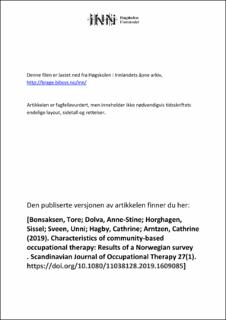Characteristics of community-based occupational therapy: Results of a Norwegian survey
Bonsaksen, Tore; Dolva, Anne-Stine; Horghagen, Sissel; Sveen, Unni; Hagby, Cathrine; Arntzen, Cathrine
Peer reviewed, Journal article
Published version
Permanent lenke
https://hdl.handle.net/11250/2683813Utgivelsesdato
2019Metadata
Vis full innførselSamlinger
Sammendrag
Background: Ongoing changes in healthcare delivery systems in Norway increasingly require community-based services, and the changes will likely affect the working conditions and opportunities for occupational therapists. Aim: To characterize occupational therapy in community based practice in Norway. Material and methods: A cross-sectional, descriptive survey design was applied using a questionnaire related to personal and organizational characteristics. Participants (n ¼ 561) were recruited among community-working occupational therapists in Norway registered as members of Ergoterapeutene. Data were analyzed with descriptive statistics. Results: The majority of the participants was female and had an average of 16.5 years of professional experience. They reported to spend about half of their working hours on direct work with clients. For many, work with assistive technology was a main task, accounting for approximately half their working hours. Only a small proportion worked in municipalities that had merged with others, but for a larger proportion (27%) a merger had been decided and was in preparation. Conclusion: This study established some basic information regarding Norwegian communitybased occupational therapy and the municipalities where occupational therapists work. Significance: With this study serving as a baseline, we may be able to track how changes will affect community-based occupational therapy practice in the near future.
